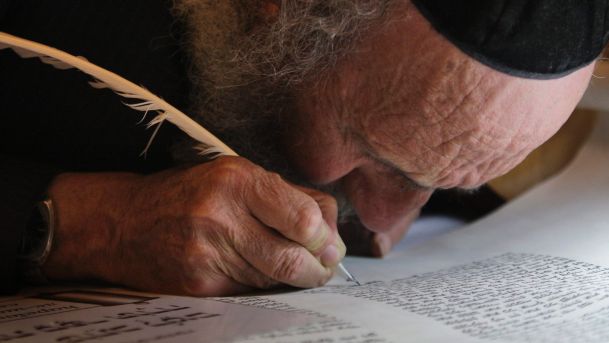
By Rabbi Ari Enkin, Rabbinic Director, United with Israel
There are thousands of laws related to the writing of Torah scrolls and other sacred texts. The most important requirement, perhaps, is that the scribe be a pious and God-fearing person.
A Torah scroll is handwritten by a scribe using a feather and special ink on carefully prepared parchment. It comprises between 62 and 84 sheets of parchment. The sheets of parchment are then sewn together with sinews to form one long scroll. The parchment is cured, tanned, scraped and prepared according to very specific requirement. A Torah contains 304,805 letters.
As one can imagine, it takes many months, perhaps a year, to write a Torah scroll. The style of writing used when writing a Torah scroll is known as Ktav Ashurit (Ashurite Script). While most Torah scrolls stand around two feet in height and weigh 20-25 pounds, some can be quite large and heavy. They can also be made miniature and lightweight.
The Parchment
A Torah scroll may only be written on parchment from the skin of a kosher animal. Parchment made of fish skin cannot be used for this purpose because fish skin gives off an unpleasant odor, which is unbecoming to a Torah scroll. The parchment must be prepared with the intention that it is to be used for a Torah scroll. If the parchment was prepared for some other purpose in mind, it may not subsequently be used to write a Torah. Before beginning to write a Torah scroll, the scribe must mark off the lines on the parchment with slight grooves. Most parchments come with the grooves/lines etched in already, so the scribe doesn’t have to do it.
The Ink
Only black ink may be used. If ink of any other color was used, the Torah is non-kosher. The ink must also be permanent and non-erasable. In ancient times, the ink used for writing a Torah scroll was obtained by boiling oils, tar and wax together. After that, tree sap and even honey was added to the mixture. Nowadays, scribes prepare ink using gall-nut juice and gum. The black color is achieved by adding various tints. Torah ink can also generally be purchased already made.
The Writing
As mentioned, the Torah is written with a feather or reed pen, filling its tip with the ink. An iron pen may not be used, as iron is representative of weapons and death, while the Torah is representative of peace and life. So too, and iron or metal pen would likely puncture the parchment, rendering it non-kosher. The letters of a Torah scroll must be written in the “Assyrian” script. If any other Hebrew script was used (and there are several!), the Torah is invalid. There are many laws on how each and every letter must be written. If even one letter is missing, or even if one letter is merely cracked or smudged, the entire Torah is invalid. It goes without saying that a printed or mechanically produced Torah is invalid.
The Scribe
It takes much study and apprenticeship to become a scribe, not to mention skill and patience. There are thousands of laws related to the writing of Torah scrolls and other sacred texts that must be memorized. The most important requirement, perhaps, is that the scribe be a pious and God-fearing person.
The scribe is required to write a Torah scroll by copying the words of the Torah, letter by letter, from a printed text. This is true even with regard to the verses and words that everyone knows by heart! It just can’t be done by heart…not a word of it! A scribe is required to work with a printed Bible open in front of him. It is important that a right-handed scribe writes only with his right hand, and a left-handed scribe only with his left hand. Some scribes immerse in a mikvah, a ritual bath, each day before they begin to write.
Do You Love Israel? Make a Donation - Show Your Support!
Donate to vital charities that help protect Israeli citizens and inspire millions around the world to support Israel too!
Now more than ever, Israel needs your help to fight and win the war -- including on the battlefield of public opinion.
Antisemitism, anti-Israel bias and boycotts are out of control. Israel's enemies are inciting terror and violence against innocent Israelis and Jews around the world. Help us fight back!




